Hiking Journal
May 2014
indian creek canyon
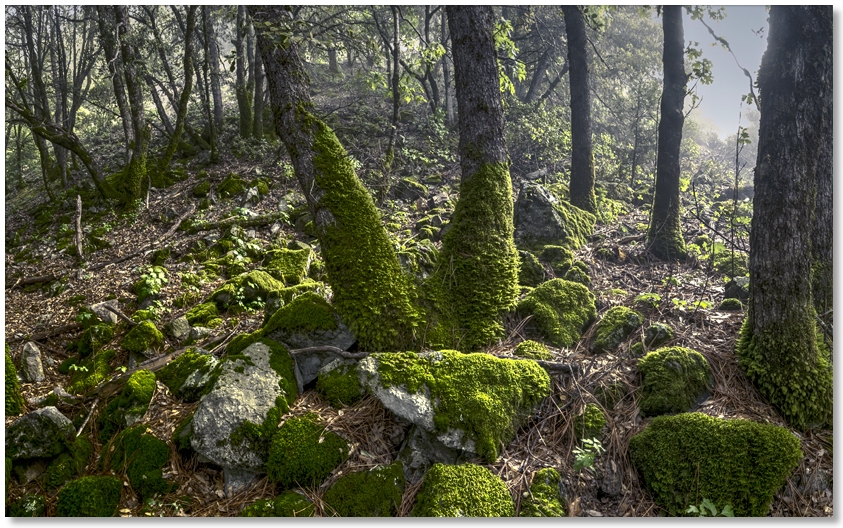
Rain the night before left the moss-covered slabs in Winton Canyon too slippery for my tastes so I went up Indian Creek from the PCT. Mushrooms and lilies were popping up along the trail and the moss was blindingly green. A little more water in the creek than normal but after such a dry winter I forgot what "normal" looked like. Followed a bear trail for awhile then switched to leap-frogging back and forth over the creek. Made it up a little farther than my last trip but got tired of slipping on wet rocks. A little over 7 miles out and back from Vista Point.
more indian creek canyon
With the weather warming up, I could get an early start without freezing, so I set out from Vista Point at 6 am, headed for Indian Creek Canyon again. Everything seemed to be blooming at once, including the poison oak. There were dogwoods along the creeks, irises along the trails, and clumps of azaleas where you wouldn't expect them at all.
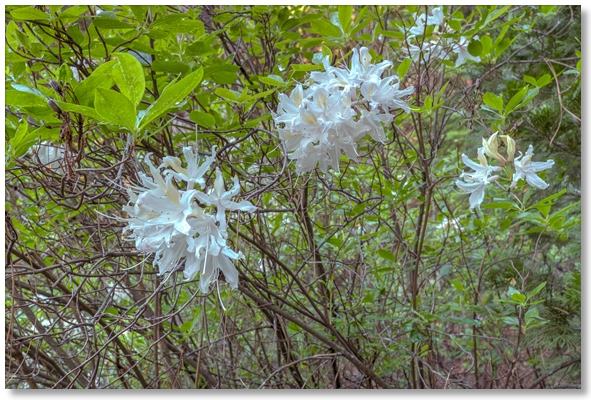
The plan was to go up a ridge just east of the canyon to get an overview of what the area looked like between the PCT and the Crags themselves. The direct route would be to just head up the creek, but the going was slow with numerous creek crossings that wouldn't be much fun if there was ever a "wet" winter around here again.
I went about a ½ mile upstream, then headed up a small canyon on the right. The terrain could be replicated easily by covering a very steep street with a few inches of pea gravel, then a few inches of dry breakfast cereal [to simulate dead manzanita and oak leaves], the setting up hundreds of 55-gallon drums [to simulate brush], and then treading your way through the labyrinth you've just created. The oaks were soon replaced by even more manzanita, and a new "sport" was born — brushclimbing!
By grabbing hold of manzanita branches, I could pull myself upwards. By repeating this tactic over and over I could make my way up impossibly steep hillsides. Drawbacks, aside from permanently scarred lower legs, were sometimes grabbing onto a holly branch by mistake, but the advantages seemed to outweigh the dangers, so up I went, spider-like. The brush was thick enough that if I did slip backwards [which I did all too often] the bush below me would arrest my fall. I began to entertain thoughts of a complete clothing line devoted exclusively to brushclimbing, with everything made out of thick carpet.
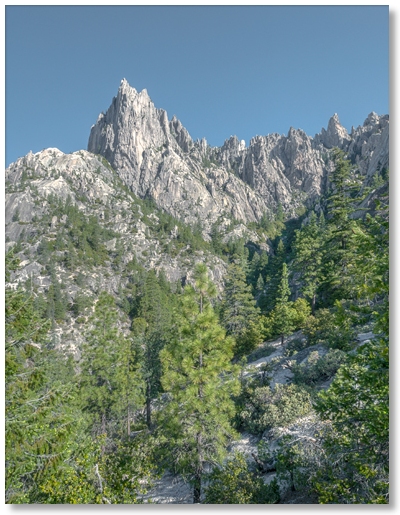
Finally breaking out onto a much more sparsely covered ridge, I got my first view of the rocks above. I could hear the creek far below and imagining how nice it would be to soak my embattled legs in the cold water, I made my way downhill, in a more-or-less controlled descent. The best way to get up to the rocks above would have to be by using the creek, and not the ridges. After some harrowing moments tiptoeing along on moss-covered rocks I reached the creek, and paused for awhile at the spot below.

After laboring my way up the hot, brush-choked hillsides I had an epiphany and vowed that the creek would be the only sensible way to explore the upper canyon, and I plan to come back soon and look for other pools like the one above.
As an added touch to a rewarding but strenuous day, I surprised a large black bear at one of my creek crossings on the way down the canyon, and was amazed at how such a large animal could move so silently through the forest. Aside from the initial crashing noises when he bolted away, he crossed the creek and circled back around on the opposite side without making the slightest sound. These few moments made the entire hike worthwhile — a warm sunny day, azaleas you could smell from a mile away, a beautiful pool and waterfall, and a bear...
indian creek canyon revisited

Another nice day signaled another hike over to Indian Creek Canyon. I hoped to find a repeatable route along the creek that I could use if the water levels ever return to "normal". The bear paths I use are easier than boring through the underbrush but aren't always the straightest route up the canyon, as whoever made them seems intent on wandering here and there, rather than making a beeline from the PCT to the rocks above.
A bit more cautious now after seeing the impressive looking bear last time, I knew that with all of the dry branches and dead leaves that covered the forest floor I'd be making enough noise to alert anything of my approach within miles. The blooming plants, like the Iris below, were showing signs of passing their peak and were seen less and less. The Azaleas, however, were still going strong, and I smelled far more of them than I saw.
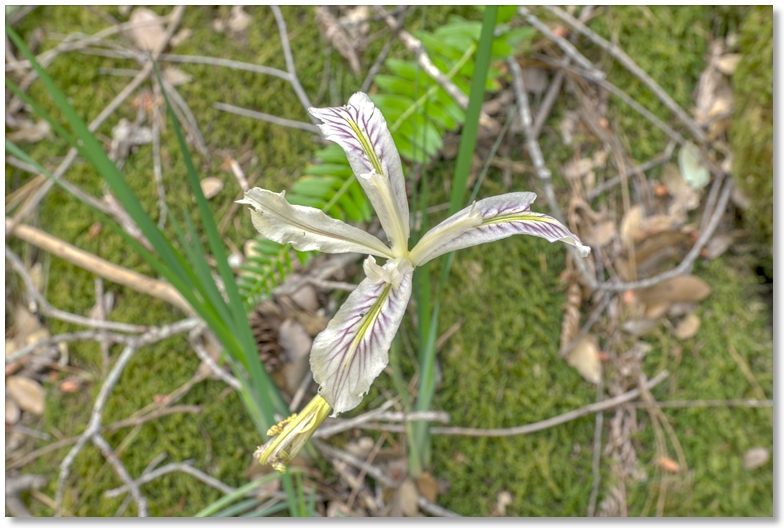
I made it about ¼ mile farther than I did last time but at this point the canyon had narrowed down considerably, which eliminated any chance of finding a path in the woods on either side of the creek, and made boulder-hopping the only method of progress. I decided to save the upper part of the canyon for another day and got back to Vista Point after 8½ miles and 3 hours of moving time.
disappearing creek
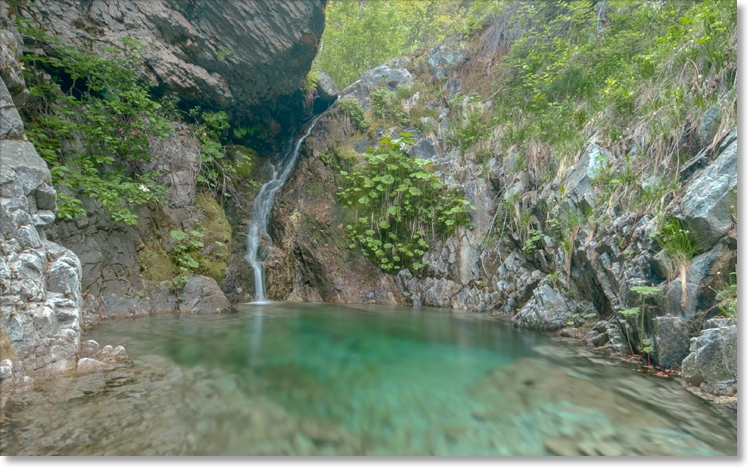
Hiked along the PCT to the aptly-named Disappearing Creek, then headed up the canyon. Although I can't remember ever seeing any water in the lower section, one look at the boulder field in the creekbed will tell you that at sometime during the year there is a large amount of water coming down.
The photo above shows how cool the creek can look before the water "disappears" and goes underground. If you entered the canyon in the upper section you'd never think that it's the same "creek" that hikers see from farther down on the PCT. I made it up about as far as the third waterfall that has to be passed by climbing up and around when my knees said "enough is enough!" and I turned and headed uphill to reach the PCT.
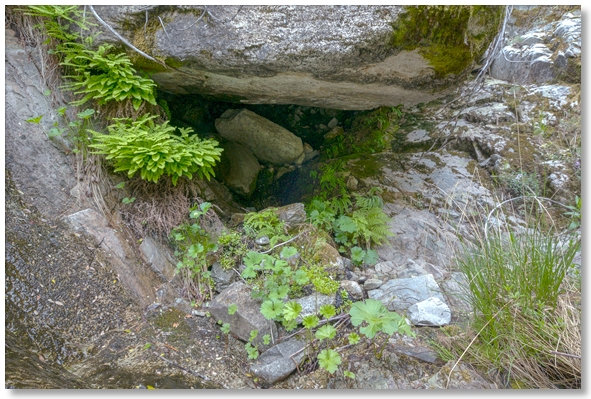
Although coming back down the trail seemed easier than backtracking down the creekbed, it was not without its sticky moments on the way up to the trail. Fortunately, my newly aquired brushclimbing skills paid off, as there were some stretches that would have challenged even a small rodent. The canyon offers quick access to this seldom-visited section of the Crags, and even the PCT is stark and overgrown in spots due to lack of use, except by through-hikers.